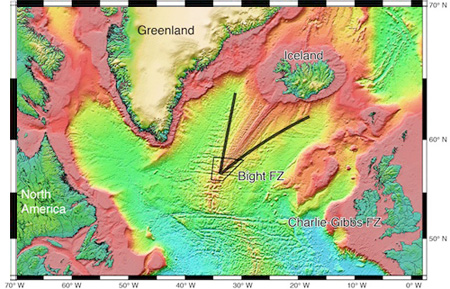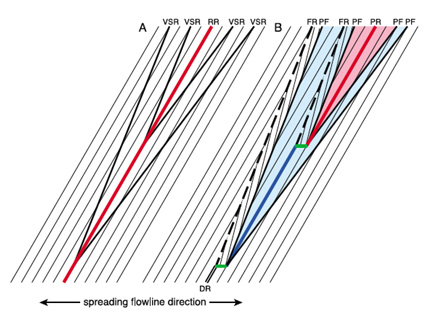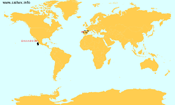Science Overview
For a quick summary of the area we're studying and our scientific objectives, see below. For more information, we've put together a more complete project description for scientists (and anyone else not afraid to wade into lots of scientific jargon).
Where...
We're studying an area at the southern end of the Reykjanes Ridge (RR), which is the section of the Mid-Atlantic Ridge (MAR) just south of Iceland (see figure). This area, right around the Bight Fracture Zone (FZ), marks the transition between the more typical ridge orientation (near orthogonal to plate spreading) south of the Bight Fracture Zone, to the highly oblique (~30º from perpendicular) spreading ridge of the Reykjanes Ridge. In addition to its oblique spreading, the RR also has a topographic axial high, which is attributed to extra mantle melting due to the Iceland hotspot. The least understood aspect of the Reykjanes Ridge is the V-shaped ridges that flank it (see figure below), and the corresponding lack of transform faults, which commonly occur along the rest of the MAR south of the Bight Fracture Zone. These V-shaped ridges result from the Mid-Atlantic Ridge reorienting to stay aligned with the Iceland hotspot to the north. The southern end of the Reykjanes Ridge has never been studied in detail, but holds important clues to better understanding how the unusual V-shaped ridges form.

Fig 1: Map of the North Atlantic with our study area outlined in the black polygon. Thick black V shows the boundary of the V-shaped ridges, which come to a point at the Bight Fracture Zone (FZ).
While it's clear these V-shaped ridges are associated with the Iceland hotspot, exactly how they're related is still a matter of debate. There are two major competing theories:
(1) Thermal origin — the first theory proposes that pulses of warmer mantle from the Icelandic hotspot causes a change from brittle behavior (what we'd typically expect from oceanic crust) to more ductile behavior, so that the ridge reorients itself without the usual steps between ridge segments that normally create fracture zones. This theory is also sometimes referred to as the "pulsing plume" theory, since it's proposed that periodic pulses in plume activity create the alternating regions of thick and thin crust that form the V-shaped ridges.
(2) Rift propagation — the second theory is that the V-shaped ridges are actually the result of a series of propagating rifts. Propagating rifts are a common way for mid-ocean ridges to move locations or orientations (in this case shifting gradually eastwards toward the Iceland hotspot). A new ridge segment will form slightly offset from the orignal one, and propagate parallel to the existing rift system, which gradually dies off as the new segment starts taking over. Ridge jumps are known to have occured on land in Iceland, as well as some evidence for them occuring along the Reykjanes Ridge.
Why...
Why do we care? Well, it turns out that understanding whether this is thermal in origin, as is commonly accepted, has implications for our understanding of the Iceland hotspost, its origin and dynamics, and its interaction with the ridge. The thermal model, although completely untested, is almost universally assumed to be true, and is used to infer important conclusions about processes in the Earth's mantle. Observations and models of this system have had considerable impact in many studies of global importance, including the origin of large igneous provinces, mantle convection and thermal evolution. A better understanding of the dynamics of the Reykjanes Ridge reorganization will be important for many geodynamic problems with wide-ranging implications.
What...
Fortunately, these two models have different predictions that are testable with the right data, which is where our current cruise comes in! The propagating rift theory predicts that the tip of reorganization (near the Bight FZ and within our study area) should have a zone of lithosphere that's been transferred from one plate to the other (see panel B in figure below). The thermal model does not predict this, and in fact predicts symmetry about the ridge axis (see panel A). There is already evidence further north on the ridge that magnetic anomalies are NOT symmetric about the axis. What we're looking for on this research cruise is evidence, such as the presence or absence of a zone of transferred lithosphere, that would support one hypothesis over the other.

Fig 2 (from Hey et al, 2010): (A) Thermal ('pulsing plume') model predicts symmetry about ridge axis (red line labeled RR). (B) Propagating rift model predicts zone of transferred lithosphere and slight assymetry. VSR=V-shaped ridges;
PR = propagating rift; PS = pseudofaults; FR (dashed lines) = failed rifts.
How...
We're using our ocean-going laboratory, the R/V Marcus G. Langseth, to gather geophysical data of the seafloor, including multibeam bathymetry data, gravity measurements, and magnetics. These data will allow us to determine whether or not there is a zone of transferred lithosphere in this area, evaluate the symmetry (or lack thereof) about the ridge axis, and, if all goes well, resolve the debate between the two competing models.
For further explanation, project details, and related references, take a look at our detailed project description. (Warning: technical jargon ahead!)
Track the ship's current location and watch our progress.
The R/V Marcus G. Langseth is a 235-ft research vessel owned by the National Science Foundation and operated by the Lamont-Doherty Earth Observatory. The ship is a floating geophysical and seismic laboratory, with the ability to measure various properties of (and below) the earth's seafloor. It's part of the UNOLS fleet, an organization of academic institutions and oceanographic research vessels.
See the ship specifications for more information.
Have a question for us about the project, life onboard the ship, or what it's like to do science in the field? Email us and we'll direct your question to a member of the science or ship crew.

